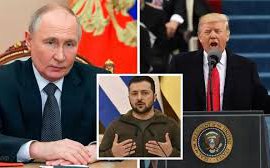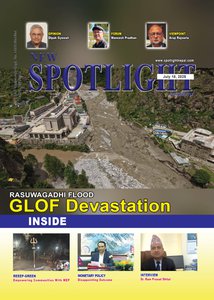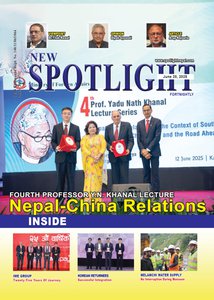
G7 is unravelling before our eyes: it dropped mentioning any support for Ukraine; there was disagreement about uniting for a “regime change” in Iran; no critical issues such as next week’s NATO summit to iron out conflicting agenda could be discussed; its foundational pillar, the US under Trump effectively declared that summit of the leaders of the Collective West a waste of time; and it could not even release a joint communique. Indeed, as Trump abandoned the meeting, he upended the decade-old G7 policies of kicking out Russia and excluding China from the outset by characterizing them as big mistakes that have led to the current world disorder. All this effectively diminished the remaining G6 as midgets on the world stage. It proves the prevalent view in the Global South, best articulated by former Sri Lankan president Ranil Wickremesinghe, that G7 is irrelevant and what really matters in the years ahead is G20 in a multipolar world where BRICS members are a majority both in numbers and economic prowess.
The subject of decline of great powers, indeed of civilizations, has been of interest to many scholars; and it might be useful to focus on the gist of what they had to say before using those insights to try and make sense of the here and now. The first to try and overturn a linear and hegemonic view of history upheld by dominant powers was Edward Gibbonin the last quartile of the 18th century, who studied the decline of the Roman Empire, concluding that it was the loss of its civic virtues that weakened it and allowed external forces to overwhelm it. Writing after the disastrous internecine European war called with Eurocentric myopia as the First World War a century and a quarter after Gibbon, Oswald Spengler saw the decline of the West in a money grubbing plutocracy that disguised itself in the garb of democracy. Writing about all different human civilizations across the globe during the period that saw the rise of Fascism in Europe and the carnage of the second World War, Arnold Toynbee perceptively noted that loss of spiritual legitimacy, an alienated internal and an aggrieved external set of proletariats (those outside the elite’s core) were the primary contributing factors that led to the decline of civilizations.
Looking at the Collective West through their scholarly lenses, one can discern striking parallels. As the ruling elites degenerate (think ‘Epstein files’, Stormy Daniels or ‘cocaine in train from Ukraine’), they strive to maintain their power by force (military suppression inside and adventurism outside) or by graft-tinged blandishments both disguised by dubious legalistic means. Whether it is Seattle and LA riots in the US, race riots in UK, or those inParis, what Bernie Sanders calls the 1% (ruling elites) are resorting to forceful suppression of discontent among the 99%. They are also trying monetary blandishments with ‘pork barrel’ budgets and social programs funded by printing money and borrowings. When elites give up on productive industrial capital and resort to using financial capital, both social and military decline are inevitable as the Italian political philosopher Giovanni Arrighi has noted.
This “living beyond one’s means” has resulted in the US drowning in a 37 trillion-dollar debt. Its interest payment is bigger than its defense budget which is bigger than the sum of that of the next top military powers in the world. It was unthinkable a decade or so back but is now openly speculated that the US might default on its debt, thus throwing the entire global financial world into turmoil. It is, as Arrighi and others predicted, the result of an elite shunning manufacturing (“exporting dirty manufacturing to under-polluted Third World countries” as US treasury secretary Larry Summersnotoriously said) and relying on finance capital (and shoddy banking Ponzi schemes) to retain their hold. Unfortunately for them, with the outflow of manufacturing went the capacity to build weapons, which incidentally has shifted to countries sanctioned by the Collective West such as Russia, Iran, North Korea and China.
The entire edifice of Western global economic dominance is based on the post-World War-2 Bretton Woods arrangements that required the US dollar to be both the world’s trading and reserve currency. The first nail in that coffin was hammered in 1971 when Richard Nixon delinked the dollar from gold and allowed it to float, thus enabling the US to print dollars to finance its consumption as well as the Vietnam War. With the collapse of the Soviet Union, however, the US began weaponizing the dollar and borrowing even more to sustain a burgeoning consumptive lifestyle.
Although it did lead to a successful revolt of oil supplying nations in the form of an OPEC counterweight, the damage to Western financial dominance was contained. However, subsequent weaponization of the dollar and the financial trading system by the Collective Westwith the failure of the US to fulfil its role as a custodian of that dollarhas backfired: it led to a process of BRICS decoupling from the dollar and jeopardizing the US’s ability to print money. The sanctioned countries have hit back by dumping US treasury bills, shifting to gold as reserve and trading in their own currencies.
While this collapsing old order was called Pax Americana (a successor to Pax Brittanica that collapsed with the end of World War-2), it was primarily maintained by a balance of power between the Collective West and the Communist Block. However, despite the “peace” in the terminology, there were many wasteful wars initiated by the US(with its NATO allies in tow) to enforce or enlarge its hegemony: Korea (1950-53), Vietnam (1955-75), Iraq-Iran (1980-88), Yugoslavia (1990- 2001), Afghanistan (2001-21), Kuwait (1990-91), Iraq (2003-11), and Libya (2011-20).
Currently other such wars are: the use of Ukraine as a proxy for war against Russia;the ousting of Assad in Syria and replacing him with a terrorist with a 10 million dollar bounty on his head; and the most recent Israeli genocide in Gaza and aggression against Iran. While earlier wars had a more dominant military narrative behind them, the latter ones are more overtly about resource capture. In Syria, it was for oil in Kirkuk; in Libya, it was to prevent a gold dinar challenging US dollar supremacy; and in Ukraine it was for both control of Ukraine’s agriculture land and rare minerals as well as dismemberment of Russia(also here) for its natural resources.
When old orders collapse, chaos ensues with repercussions far and wide. Accompanying the inability of the old hegemon to impose its will (and its definition of what “order” is) is the rise of hitherto suppressed tensions all around. On the surface, they may look like law-and-order or military issues, but underneath roil tectonic forces of ancient rivalries. Behind the conflict in Ukraine (its eastern versus its western half), lies the split in Christianity in 1054AD into Roman Catholic and Eastern (including Russian) Orthodox Christianity. That is what prompted Russian foreign minister Sergei Lavrov to reject the offer of Pope Leo XIV of Rome for mediation in the Vatican, saying two Orthodox Christian countries meeting in the seat of Catholicism would be most inappropriate.
The religious situation in West Asia is even more complicated. On the one hand there is the 1000-year old Shia-Sunni divide where rulers of many countries are mostly Sunni while a significant part of their population are Shia as in Iran. On the other is the rifts and unnatural coalitions (as between Zionists and US Evangelicals as well as the AIPAC) within Abrahamic religions where “us versus them” gentile, unbeliever, kaffir divide underlies the seismic ruptures. Its most rabid form is Netanyahu using the Bible’s Old Testament to justify his genocide in Gaza. As the Old World Order disintegrates, these ancient rifts will achieve increasing salience that will sorely tax the inclusive, ecumenical statesmanship of new leaders who would have to design a New World Order of the future.

Dipak Gyawali
Gyawali is Pragya (Academician) of the Nepal Academy of Science and Technology (NAST) and former minister of water resources.
- Behind Nepal’s Political Instability: Flaws In Loktantra’s Ethical Foundation
- Jul 15, 2025
- Overcoming Indo-Pak Conflict The Dara Shikoh Way
- May 13, 2025
- Re-Thinking Democracy: Why South Asians Are worried
- Mar 17, 2025
- Nepal’s Governance Mired In Endemic Corruption
- Feb 20, 2025
- What Might The Age Of Trump Look Like?
- Jan 22, 2025















